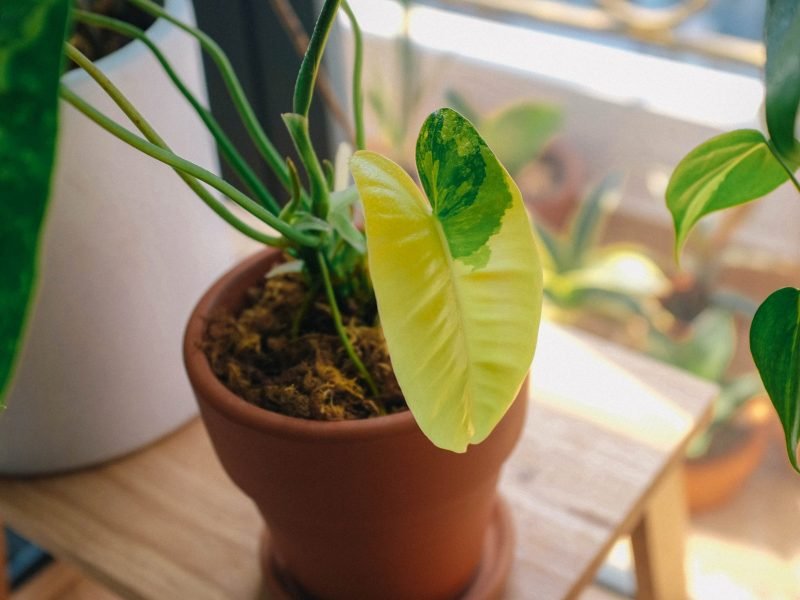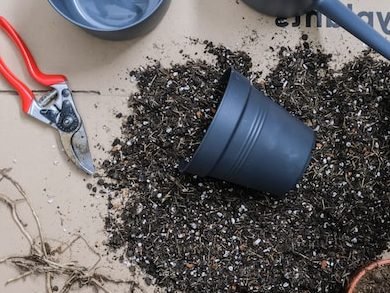
There are quite a few reasons why your Arrowhead plant may be turning yellow so it’s important you eliminate them one by one. The most common reasons are to do with watering but it is worth looking at other factors such as humidity, light and nutrient levels before changing anything in your care routine.
Underwatering
If your Arrowhead’s leaves are yellow, dry and crispy it may be because you have not given it enough water for a while. Over time, consistent underwatering will mean your plant begins to dry out, turn yellow and become very limp.
It is important to get to know each of your houseplants so you get a feel when they are ready for watering. There are a few really easy ways to do this. First check the moisture at the top of the soil, if it is still damp then it won’t need watering for another few days. The second method is lifting up your Arrowhead before and after watering you so you start to gauge how heavy the soil is when it is in need of water. Make sure to pick it up by the pot rather than the leaves or stems as you don’t want to damage the plant.
If you think that underwatering is the cause of your Arrowhead’s yellow leaves then it is important that you reintroduce watering slowly. You may think that the best thing to do is drown your plant in water but this will actually shock your plant and cause even more harm. Instead, you want to water it little but often for a few days to make sure the soil gets a good soaking.
Overwatering
Another cause of yellow leaves on an Arrowhead plant is overwatering. If the yellow leaves are falling off the plant, and are not dry or crispy then this is most likely the cause.
Arrowheads don’t like sitting in pools of water for too long and it can cause their roots to rot. This will mean the plant is unstable and unable to get nutrients from the soil and the long stems cannot hold up the leaves leaving the plant floppy.
If you think your Arrowhead is waterlogged then check the moisture of the soil immediately and adjust watering accordingly. We also recommend replacing the potting soil straight away (rather than waiting for it to naturally dry out) so that the roots can begin to recover.
Top tip: waterlogged soil can give off a damp, musty smell so get up close to your plants every once in a while to check!
Dry air
Arrowheads like slightly humid environments and can struggle in homes with dry air. This can be especially damaging in winter months when we often have the heating on for a lot of the day. If the yellow leaves on your Arrowhead starting off with brown or yellow spotting on the leaf, then this may be the cause.
To increase the humidity for your Arrowhead we recommend misting the leaves, putting together a pebble tray or investing in a humidifier.
Nutrient Deficiency
Another reason your Arrowhead plant may be developing yellow leaves is a lack of nutrients. This can happen if you haven’t switched out the potting soil in over a year or you don’t fertilise during the growth months.
We recommend using a diluted water-soluble fertiliser during spring and summer to make sure your plant is getting all the nutrients it needs.
Sunburn
The correct light level is a really important element to monitor when taking care of your Arrowhead plant. If your plant is receiving too much bright direct sunlight each day you may start to notice yellow patches forming on the leaves. This is where the leaves are becoming sunburnt, something which is unfortunately irreversible.
If your Arrowhead is receiving too much light then make sure to move it to a slightly shadier spot in your home immediately. You may be able to move it closer to the window in winter when the sun isn’t as strong so keep an eye on lighting changes throughout the year. If you prefer you can carefully trim away the burnt patches on the leaves so your Arrowhead looks healthier and can focus on producing new healthy growth.
Natural Ageing
If you have gone through all of the above but none of it really fits what is going on with your Arrowhead then it may simply be natural ageing. Over time it is totally normal for your Arrowhead to drop some of its oldest leaves as it focuses on new bigger growth. These old leaves will first turn yellow before falling off the plant.
If the rate of yellowing is quite slow (1 or 2 every few months) then it probably is nothing to worry about and is simply part of the natural shedding process. Do keep an eye on how often they are turning yellow though as if the rate speeds up then it is worth checking the plant over again for the problems we outlined above.
Luckily, if you have caught the problem early and there aren’t too many yellow leaves on your Arrowhead then correcting the issue should solve it and you should start to see new luscious green growth pretty soon! Many people ask us whether or not they should trim off the yellow leaves and we always say yes! Not only will it make your plant look healthier but it stops it wasting energy trying to save a dead leaf. There is no going back from dry crispy or sunburnt leaves so it is better to just get rid.
You can find out more about caring for your plant in our Arrowhead guide. Or if you want to learn everything there is to know about houseplant care then our downloadable ebook is the one for you!!
Complete Houseplant Care eBook
Our comprehensive (and rather good looking) eBook that will teach you everything you need to know to successfully care for, and maintain your houseplants!
Buy on














